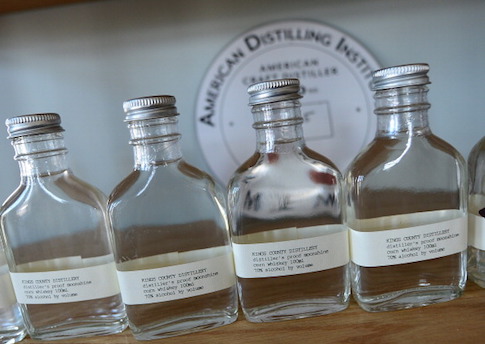The first time I tried moonshine was in the 1990s at a Fourth of July party in Washington, D.C. Someone handed me a mason jar filled with a clear liquid. The mere whiff of it made me wince—it smelled like paint thinner. But since everyone was giving it a try, I agreed to take a swig. It was awful, and I quickly returned to my vodka-soda while nodding to the beat of Third Eye Blind. (Did I mention this party was in the 1990s?)
So who on earth would drink this stuff? As Kevin Kosar writes in Moonshine: A Global History, it turns out lots of people do and for all sorts of reasons (many of them not good). "To the denizens of a slum in Nigeria, Philadelphia or Manchester, it is a cheap, quick buzz that helps blot out the misery of existence." College kids drink it to "prove one's audacity and wildness to peers." For the libertarian, "moonshine is a declaration of freedom and revolt against government." And for the "foodie" (I'll say "hipster"), "licit or illicit moonshine provides the opportunity to enjoy 'authentic' liquor."
Wait—isn’t "licit moonshine" an oxymoron? Isn't a spirit moonshine because it is by definition illicit? For the most part, the answer is yes. It's made in the backwoods of West Virginia and Tennessee, in remote villages in West Africa and Indonesia, in Chinese factories and, well, a lot of places in Russia. (Kosar mentions knock-off Johnnie Walker from China—printed on the bottle was "Johnnie Worker Red Labial.")
Moonshiners evade the government and its "revenuers." They avoid the kinds of regulations and taxes that burden the rest of the liquor industry. Of course some of those regulations are what keep the rest of us safe.
But sadly there are many drinkers, especially in the Third World, who cannot afford heavily taxed liquor. And moonshine producers are happy to supply. But as Kosar relates, the product itself can be extremely harmful—the parts of a pot still can come from a car, the spirit can contain methanol (used in formaldehyde and a cause of blindness) and isopropyl alcohol, which results in severe nausea and even death.
In Chasing the White Dog: An Amateur Outlaw's Adventures in Moonshine, author Max Watman in fact risks death by sampling what turns out to be lethal hooch. "Bile. As if I'd burped up vomit," he writes. "But stomach acid and puke is thick and viscous; this was sharp and thin. As if you took stomach acid from acid reflux and strained it through a cheesecloth and blended in a dash of simple syrup to sweeten it."
Kosar, meanwhile, cites a report in the Economist, in which Kenyan "moonshine was being made from water with feces in it, and rotting rats and women’s underwear were found in the brew being distilled into chang'aa." Think about that the next time someone hands you a mason jar.
It is estimated that 18,000 Indonesians die each year from ingesting moonshine. In Russia, the number of moonshine (samogon) related deaths totals 40,000 annually. And yet the demand continues to rise. According to one study noted by Kosar, "U.S. legal moonshine sales increased 1,000 percent between 2010 and 2014."
Again, that's legal moonshine. As it turns out, we are drawn to the thrill of an illicit spirit, but we’ll happily drink the licit version just to play it safe—and companies like Jack Daniel's, Jim Beam, and Buffalo Trace are happy to oblige.
So what exactly is the allure that draws us in? In America, moonshine has largely been romanticized—think Dukes of Hazzard. White Lightning thrived during Prohibition but left a negative impression thanks to organized crime and the likes of Al Capone.
There was a resurgence in popularity, which Kosar traces to 1956 and the Robert Mitchum movie Thunder Road. It involved both moonshine and racing—Kosar doesn’t mention that the movie poster was the inspiration for Bruce Springsteen's song, but he does rightly point out the link between moonshine and the origins of NASCAR.
Moonshine is a (pardon the pun) perfectly distilled history blended with thoughtful policy prescriptives. "In the healthiest of all moonshine markets, there are multiple producers who compete to provide the best product to the consumer at the best price," writes Kosar, a senior fellow at the R Street Institute think tank. "The moonshine market is worst still when the consumers lack choice. In the absence of options, licit or illicit, people often will take whatever they are offered. And this is all the more true if the consumers are addicts, for whom health risks are an afterthought in the chase for a buzz."
A few years back while on the Bourbon Trail, I met Steve Beam of the Limestone Branch Distillery. He was a friendly fellow who provided a sample of his Moonpie Moonshine. It was delicious. But again, it came from Limestone Branch Distillery, a legit operation. Sure, it's a long way from Thunder Road, but at least I didn’t have to worry about rotting rats or going blind.
